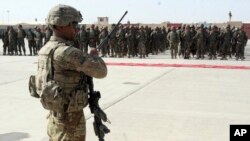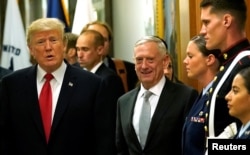The Trump administration has yet to complete its strategy to stabilize Afghanistan, with one Pentagon official telling VOA it would be "weeks" before a plan was finalized and announced.
And when President Donald Trump was asked by a reporter Thursday whether he would deploy additional American troops to the war-torn country, the president responded, "We'll see."
Trump made the comments during a visit to the Pentagon, where he and Vice President Mike Pence met with Secretary of Defense Jim Mattis, Secretary of State Rex Tillerson, Chairman of the Joint Chiefs of Staff General Joe Dunford, and other key officials.
Pentagon officials close to the meeting told VOA the president would receive a global security update during the visit.
"This was a global layout," Pentagon spokesperson Dana White told reporters after Thursday's meeting, which lasted about two hours.
White said the discussion focused on economic tools that could influence international affairs, in additional to diplomatic and military efforts.
The visit to the U.S. military headquarters comes a day after the president gathered his national security team at the White House to discuss South Asia strategy.
U.S. officials have said the president's team is split over what is arguably the region's biggest conundrum: How to stabilize Afghanistan. The military contingency — Mattis, Dunford and National Security Adviser H.R. McMaster — all seem to agree with their commander on the ground that a troop increase in Afghanistan should be one part of a complex solution.
But White House Chief Strategist Steve Bannon appears to have not "bought into" that solution, according to Michael Kugelman, deputy director of the Woodrow Wilson Center's Asia Program.
"The Bannon wing is really the holdout," Kugelman told VOA on Wednesday. "The Bannon group simply wants to reduce the U.S. footprint in the world, which President Trump himself has suggested he really wanted to do as well."
Pentagon spokesperson White confirmed to reporters Thursday that a decision on Afghanistan strategy would not come in the immediate future. "I don't anticipate any decisions being made this week," she said.
The president also received an update on the counter-Islamic State fight in Iraq, Syria and Afghanistan.
"We're doing very well against ISIS. ISIS is falling fast, very fast," Trump told reporters ahead of the meeting, using one of many acronyms for the terror group.
Last week, the Pentagon announced that a U.S. strike killed the leader of Islamic State-Khorasan, the IS affiliate in Afghanistan. The Iraqi government also recently announced it had pushed the terror group out of Mosul, the largest populated city once under Islamic State control.
Following Thursday's meeting, Trump shook hands with more than two dozen service members at the Pentagon before returning to the White House.








